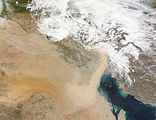Dust
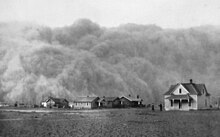
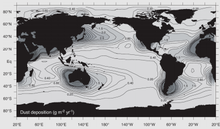
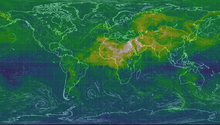


Dustis made offineparticlesof solidmatter.[1]On Earth, it generally consists of particles in theatmospherethat come from various sources such assoillifted by wind (anaeolian process),volcanic eruptions,andpollution.Dust in homes is composed of about 20–50% dead skincells.[2]The rest, and in offices and otherbuilt environments,is composed of small amounts of plantpollen,humanhairs,animalfur,textilefibers,paperfibers,mineralsfrom outdoor soil, burntmeteoriteparticles, and many othermaterialswhich may be found in the local environment.[3]
Atmospheric

Atmospheric or wind-bornefugitive dust,also known asaeolian dust,comes from arid and dry regions where high speed winds are able to remove mostly silt-sized material, abrading susceptible surfaces. This includes areas wheregrazing,ploughing,vehicleuse, and otherhuman behaviorshave further destabilized theland,though not all source areas have been largely affected byanthropogenic impacts.[4]One-third of the global land area is covered by dust-producing surfaces, made up ofhyper-arid regionslike theSaharawhich covers 0.9 billion hectares, anddrylandswhich occupy 5.2 billion hectares.[5]
Dust in the atmosphere is produced bysaltationandabrasive sandblastingof sand-sized grains, and it is transported through thetroposphere.This airborne dust is considered anaerosoland once in the atmosphere, it can produce strong localradiative forcing.Saharan dust, in particular, can be transported and deposited as far as theCaribbeanand theAmazon basin,and may affect airtemperatures,cause ocean cooling, and alter rainfall amounts.[4]
Middle East
Dust in the Middle East has been a historic phenomenon. Recently, because ofclimate changeand the escalating process ofdesertification,the problem has worsened dramatically. As a multi-factor phenomenon, there is not yet a clear consensus on the sources or potential solutions to the problem.
Iran
The dust inIraqandIranare migratory systems that move from west to east or east to west in the spring and have the highest intensity, concentration and extent until mid-summer. The cause of their occurrence is the lack of humidity, dry environment, low rainfall and annual droughts. Due to the decrease of rainfall in areas such as Iraq and Syria, most of the dust in Iran also originates from the areas of Iraq, Syria and Jordan.[6]
In addition to the foreign foci, there are areas inside the country that have either formed new dust foci in recent years or were from the past and their extent has increased. Among these areas, parts of southernTehran,south ofAlborz province- which in the past were plains, riverbeds, seasonal lakes and seasonal reservoirs - andGavkhoni wetlandofIsfahan provincecan be mentioned because they have become dry and prone to dust. Among other areas that have become dust centers,Qom province,the Qom salt lake and its surroundings can be mentioned, as well as theUrmia lake,which due to strong winds and due to the dryness of the lake and the reduction of its size, some areas of its bed which were under water in the past are subject to wind erosion.[6]
In Iran, the dust is already affecting more than 5 million people directly, and has emerged as a serious government issue in recent years. In theKhuzestan Province,it has led to the severe increase ofair pollution.The amount ofpollutantsin the air has surpassed more than 50 times the normal level several times in a year. Recently, initiatives such as Project-Dust have been established to directly study dust in the Middle East.[citation needed]
The continuation of drought has caused water scarcity or drying up of some wetlands and lakes such asHamonandUrmia Lake.This has turned them into centers of dust.[6]
Director General of the office of Desert Affairs of Iran's Natural Resources and Watershed Organization stated that according to the data of the 2018 studies, 30 million hectares of land in the country are affected by wind erosion, and 14 million hectares of this area are considered to be the focal points of wind erosion, which causes serious damage to infrastructure.[7]
Roads
Dust kicked up by vehicles traveling onroads[8]may make up 33% of air pollution.[9]Road dust consists of deposits of vehicle and industrialexhaust gas,particles fromtireandbrakewear,dustfrom paved roads orpotholes,and dust fromconstructionsites. Road dust is a significant contributor to the generation and release ofparticulatesinto the atmosphere.[10]Control of road dust is a significant challenge inurban areas,and also in other locations with high levels of vehicular traffic upon unsealed roads, such as mines andlandfills.
Road dust may be suppressed by mechanical methods likestreet sweeper,vehicles equipped withvacuum cleaners,[11]vegetable oilsprays,[12]or with water sprayers.Calcium chloridecan be used. Improvements inautomotive engineeringhave reduced the amount ofPM10sproduced by road traffic; the proportion representing re-suspension of existing particulates has increased as a result.
Coal
This sectionneeds expansion.You can help byadding to it.(February 2019) |
Coal dustis responsible for therespiratory diseaseknown aspneumoconiosis,includingcoal worker's pneumoconiosisdisease that occurs amongcoal miners.The danger of coal dust resulted inenvironmental lawregulating workplace air quality in some jurisdictions. In addition, if enough coal dust is dispersed within the air in a given area, in very rare circumstances, it can cause adust explosion.These circumstances are typically within confined spaces.
Control
Atmospheric
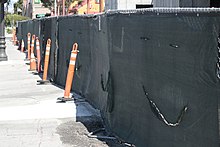
Most governmental Environmental Protection Agencies, including theUnited States Environmental Protection Agency(EPA) mandate that facilities that generate fugitive dust, minimize or mitigate the production of dust in their operation. The most frequent dust control violations occur at new residential housing developments in urban areas. United States federal law requires that construction sites obtainplanning permissionsto conduct earth moving and clearing of areas, so that plans to control dust emissions while the work is being carried out are specified. Control measures include such simple practices as spraying construction anddemolitionsites with water, and preventing the tracking of dust onto adjacent roads.
Some of the issues include:[citation needed]
- Reducing dust related health risks that includeallergicreactions,pneumoniaandasthmaticattacks.
- Improvingvisibilityandroad traffic safety.
- Providing cleaner air, cleaner vehicles and cleaner homes and promoting better health.
- Improvingagricultural productivity.[citation needed]
- Reducing vehicle maintenance costs by lowering the levels of dust that clog filters, bearings and machinery.
- Reducing driver fatigue, maintenance oncar suspensionsystems and improvingfuel economy in automobiles.
- Increasingcumulative effects—each new application builds on previous progress.
US federal laws require dust control on sources such as vacant lots, unpavedparking lots,anddirt roads.Dust in such places may be suppressed by mechanical methods,[citation needed]including paving or laying downgravel,or stabilizing the surface with water, vegetable oils[12]or otherdust suppressants,or by using water misters to suppress dust that is already airborne.[citation needed]
Domestic


Dust control is the suppression of solid particles with diameters less than 500micrometers (i.e.half a millimeter). Dust poses a health risk to children,[13]older people, and those with respiratory diseases.
House dust can become airborne easily. Care is required when removing dust to avoid causing the dust to become airborne. Afeather dustertends to agitate the dust so it lands elsewhere.
CertifiedHEPA(tested to MIL STD 282) can effectively trap 99.97% of dust at 0.3 micrometers. Not all HEPA filters can effectively stop dust; while vacuum cleaners with HEPA filters, water, or cyclones may filter more effectively than without, they may still exhaust millions of particles per cubic foot of air circulated.Central vacuum cleanerscan be effective in removing dust, especially if they are exhausted directly to the outdoors.
Air filtersdiffer greatly in theireffectiveness.Laser particle counters are an effective way to measure filter effectiveness; medical grade instruments can test for particles as small as 0.3 micrometers. In order to test for dust in the air, there are several options available. Pre-weighed filter and matched weight filters made frompolyvinyl chlorideor mixedcellulose esterare suitable for respirable dust (less than 10 micrometers in diameter).[14]
Dust resistant surfaces
A dust resistant surface is a state of prevention against dust contamination or damage, by a design or treatment of materials and items inmanufacturingor through a repair process[citation needed].A reducedtacticityof a synthetic layer or covering can protect surfaces and release small molecules that could have remained attached. A panel, container or enclosure withseamsmay feature types of strengthenedstructural rigidityorsealantto vulnerableedgesandjoins.
Outer space
Cosmic dustis widely present inouter space,where gas and dust clouds are the primary precursors forplanetary systems.Thezodiacal light,as seen in a dark night sky, is produced bysunlightreflected from particles of dust in orbit around theSun.The tails ofcometsare produced by emissions of dust and ionized gas from the body of the comet. Dust also covers solid planetary bodies, and vastdust stormscan occur onMarswhich cover almost the entire planet. Interstellar dust is found between thestars,and high concentrations producediffuse nebulaeandreflection nebulae.
Dust is widely present in thegalaxy.Ambientradiationheats dust and re-emits radiation into themicrowaveband, which may distort thecosmic microwave backgroundpower spectrum. Dust in this regime has a complicatedemission spectrumand includes both thermal dust emission andspinning dustemission.[15]
Dust samples returned from outer space have provided information about conditions of the earlysolar system.Severalspacecrafthave sought to gather samples of dust and other materials. Among these craft wasStardust,which flew past81P/Wildin 2004, and returned a capsule of the comet's remains to Earth.[16]In 2010 the JapaneseHayabusaspacecraft returned samples of dust from the surface of anasteroid.[17]
Atmospheric gallery
-
Dry, windy weather sends clouds of dust across south-easternAustralia.
-
A thick dust plume overKuwaitand the north-western tip of thePersian Gulf
Dust mites
House dust mitesare present indoors wherever humans live.[18]Positive tests for dust mite allergies are extremely common among people with asthma. Dust mites are microscopicarachnidswhose primary food is dead human skin cells, but they do not live on living people.[19]They and their feces and otherallergensthat they produce are major constituents of house dust, but because they are so heavy they are not suspended for long in the air. They are generally found on the floor and other surfaces, until disturbed (by walking, for example).[18]It could take somewhere between twenty minutes and two hours for dust mites to settle back down out of the air.
Dust mites are a nesting species that prefer a dark, warm, and humidclimate.They flourish inmattresses,bedding,upholsteredfurniture, andcarpets.[20]Their feces includeenzymesthat are released upon contact with a moist surface, which can happen when a person inhales, and these enzymes can kill cells within thehuman body.[21]House dust mites did not become a problem until humans began to use textiles, such as western styleblanketsandclothing.[22]
See also
References
- ^Dust.Merriam-Webster.Archivedfrom the original on March 14, 2017.RetrievedMay 17,2021.
- ^van Bronswijk, J. E. M. H. (1981).House Dust Biology for Allergists, Acarologists and Mycologists.J. Bronswijk. p. 37.ISBN9789027535016.OCLC9757081.
- ^Hess-Kosa, Kathleen (2002).Indoor air quality: sampling methodologies.Boca Raton, Florida:CRC Press.p. 216.ISBN9781566705394.OCLC634141112.
- ^abMiddleton, N. J.; Goudie, A. S. (June 2001). "Saharan dust: Sources and trajectories".Transactions of the Institute of British Geographers.26(2). London: 165–181.doi:10.1111/1475-5661.00013.ISSN0020-2754.
- ^Jickells, T. D.; An, Z. S.; Andersen, K. K.; Baker, A. R.; Bergametti, G.; Brooks, N.; Cao, J. J.; Boyd, P. W.; Duce, R. A.; Hunter, K. A.; Kawahata, H.; Kubilay, N.; Laroche, J.; Liss, P. S.; Mahowald, N.; Prospero, J. M.; Ridgwell, A. J.; Tegen, I.; Torres, R. (April 1, 2005). "Global Iron Connections Between Desert Dust, Ocean Biogeochemistry, and Climate".Science.308(5718): 67–71.Bibcode:2005Sci...308...67J.CiteSeerX10.1.1.686.1063.doi:10.1126/science.1105959.PMID15802595.S2CID16985005.
- ^abc"Continuity of dust in the country"تداوم گرد و غبار در کشور.Tabnak(in Persian). Tabnak. 28 July 2023.Archivedfrom the original on 20 May 2024.Retrieved9 April2024.
- ^"What is the key to effectively deal with dust in the country?".Tabnak(in Persian). Tabnak. 28 July 2023.Archivedfrom the original on 20 May 2024.Retrieved9 April2024.
کد خبر:۱۱۸۵۲۴۶
- ^"Road Dust - Something To Sneeze About".ScienceDaily.November 30, 1999.Archivedfrom the original on July 7, 2017.RetrievedMay 17,2021.
- ^Reddy, K. Srinivas (October 27, 2007)."City pollution: road dust is villain".The Hindu.Archived fromthe originalon February 27, 2008.RetrievedMay 17,2021.
- ^"Environment Canada - Pollution and Waste - Tracking Pollution in Canada".The Green Lane.September 23, 2006. Archived fromthe originalon September 24, 2006.RetrievedMay 17,2021.
- ^Peel, G.; Michielen, M.; Parker, G. (July 8–12, 2001). "Some aspects of road sweeping vehicle automation".2001 IEEE/ASME International Conference on Advanced Intelligent Mechatronics. Proceedings (Cat. No.01TH8556).2001 IEEE/ASME International Conference on Advanced Intelligent Mechatronics. Vol. 1.Como:Institute of Electrical and Electronics Engineers.pp. 337–342.doi:10.1109/AIM.2001.936477.ISBN978-0-7803-6736-4.
- ^ab"Questions and Answers: Road Dust Control with Soapstock-A Soybean Oil By- Product".Usroads. June 1, 1998. Archived fromthe originalon April 3, 2018.RetrievedMay 17,2021.
- ^Kumar, Pooja Virendra (November 6, 2007)."50% Bangalore kids hit by asthma".The Times of India.Archivedfrom the original on November 17, 2020.RetrievedMay 17,2021.
Dust mites in the humid atmosphere of Bangalore trigger around 60% of asthma
- ^"What are the Effects of Dust on the Lungs?: OSH Answers".Canadian Centre for Occupational Health & Safety.January 3, 2018.Archivedfrom the original on January 26, 2021.RetrievedMay 17,2021.
- ^P. Finkbeiner, Douglas; Davis, Marc; Schlegel, David J. (October 20, 1999)."Extrapolation of Galactic Dust Emission at 100 Microns to CMBR Frequencies Using FIRAS".The Astrophysical Journal.524(2): 867–886.arXiv:astro-ph/9905128.Bibcode:1999ApJ...524..867F.doi:10.1086/307852.OCLC691250305.S2CID12187640.Archivedfrom the original on July 27, 2018.RetrievedMay 16,2021.
- ^Hanslmeier, Arnold (2013-01-02).Astrobiology The Search for Life in the Universe.Bentham Science Publishers. p. 104.ISBN978-1-60805-473-2.Archivedfrom the original on 2022-12-24.Retrieved2022-12-24.
- ^Ridpath, Ian (2018-04-26).A Dictionary of Astronomy.Oxford University Press. p. 497.ISBN978-0-19-254261-8.Archivedfrom the original on 2022-12-24.Retrieved2022-12-24.
- ^ab"Dust Mites".American Lung Association.Archivedfrom the original on 2022-12-23.Retrieved2022-12-23.
- ^Australia, Healthdirect (2021-09-16)."Dust mites".healthdirect.gov.au.Archivedfrom the original on 2022-12-23.Retrieved2022-12-23.
- ^Perryman, Oliver (December 14, 2020)."How to Get Rid of Dust Floating in the Air using a Air Purifier?".Dehumidifier Critic.Archivedfrom the original on May 17, 2021.RetrievedMay 17,2021.
- ^Abadi, Sara (August 2009)."Hygiene Habits".AOL Health.AOL.Archivedfrom the original on January 28, 2010.RetrievedMay 17,2021.
- ^Colloff, Matthew J (2009).Dust Mites.Dordrecht:Springer Science+Business Media.doi:10.1007/978-90-481-2224-0.ISBN978-90-481-2224-0.OCLC664094692.
Further reading
- Amato, Joseph A (2001).Dust: A History of the Small and the Invisible.University of California Press.ISBN0-520-23195-3
- Holmes, Hannah (2001).The Secret Life of Dust.Wiley.ISBN0-471-37743-0
- Steedman, Carolyn (2002).Dust.Manchester University Press.ISBN978-0-7190-6015-1



